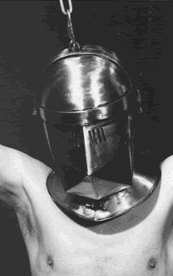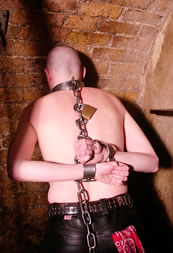| METAL IN ACTION |
 |
| That ‘man in the iron mask’ fantasy can be fulfilled with this item from Fetters |
 |
| Combination irons like these can keep an unruly subject in his place |
Heavy metal bondage is a wonderful fantasy. And in reality it can be really exciting as well. Metal bonds have no ‘give’ like leather or rope. And you don’t need to know any knots – a simple lock and key makes your subject secure. Metal bondage can be quite cheap too. A few metres of chain and some padlocks from your local DIY store can provide endless possibilities. Metal also adds weight to the bondage and sound effects as your subject clanks and rattles his way around.
But there are also some precautions to be aware of. Some metal bondage equipment is quite heavy and can cause bruising or nerve or bone damage. And you’ll need more than a pair of sharp scissors if you lose a key or it jams in the lock.
Hints and tips
- Buy a set of padlocks which all use the same key. Then you won’t need to fumble to match keys to padlocks during a scene.
- If you buy specialised equipment such as handcuffs or replica rigid irons always get a spare key and keep it somewhere safe.
- For some simple bondage, padlock lengths of chain around wrists and ankles and use further padlocks to tighten them together or attach them to furniture or hooks in the wall.
- Protect wrists and ankles using gloves and boots if there is metal putting pressure on them for any period of time.
- Using a number of short lengths of chain locked together gives more flexibility for tightening/loosening different parts of the body than one long length.
- Make sure he isn’t resting sensitive areas like the spine or the head on the sharp edges of padlocks or cuffs.
- Most keys turn easily in their locks. Don’t force them or they may snap. This is specially true for many brands of handcuff with small precision keys.
- Make sure you know how to lock and unlock all equipment before placing it on someone and that the keys are always on-hand.
- When using handcuffs don’t tighten them too much. Wrists and ankles often swell when restrained and the cuffs will dig into the swollen flesh possibly cutting off circulation and causing nerve damage. Watch for the skin colour darkening as a sign that the circulation has been restricted.
- Always ‘set’ handcuffs so they can’t tighten should your subject lean or rest on them. Avoid really cheap handcuffs if you can. They don’t have a secure way of being ‘set’.
- Suspending someone by their wrists using metal cuffs is certain to cause nerve damage. Leave these scenes to Hollywood.
- Avoid using metal objects as a gag in the mouth. Even a chain tied across an open mouth can result in an expensive dentist’s bill.
- Metal collars can be quite heavy and place a lot of pressure on the collar bones. Protective clothing underneath can be safer and more fun.
- But be careful of putting too much pressure around the neck if you use a leather or rubber hood under a metal collar.
- If someone falls over in metal bondage it is possible that the metal banging against their body could damage bones. Make sure your subject is stable and very secure.
- If metal cuffs are not adjustable and are too large in diameter for your subject’s wrists or ankles, wind a length of rope around the metal to narrow the opening.
- If locks get wet keep them lubricated with
a proper lock lubricant such as graphite.
